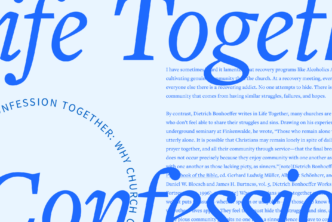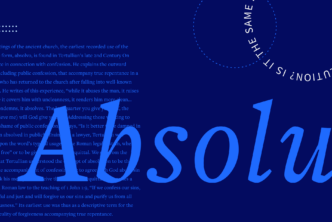Ministers of Reconciliation: Preaching on Race and the Gospel (a recent release from Lexham Press) was just nominated for a 2022 Christian Book Award® in the Ministry Resources category. Winners will be announced on May 3.
The following excerpt from the book—which includes essays exploring various perspectives on the issue of race and how pastors should tackle it from the pulpit—offers an example of the kind of wisdom you can find inside its pages.
Read on as Rev. Joel Royal explores Revelation 5:9–10 and how it can bring the light of the gospel to bear on issues of racial reconciliation and justice.
***
The book of Revelation is a strange book, full of stark and startling images.
It is written in a genre called apocalyptic, which emerged in the midst of trouble and persecution, and which tries to point us beyond present circumstances to hope in God’s victory over evil. Contrary to popular usage, the word “apocalypse” does not refer to the end of the world per se, but to an unveiling or disclosure of things that are otherwise hidden. This disclosure comes from God, usually through angelic intermediaries, to a human figure who is then responsible to communicate the vision more widely.1
Christians past and present have differing preconceptions of what the book of Revelation is and what it means. For many, the book encourages speculation about the end times. In my judgment, a more edifying approach for preachers is to discourage such speculation and to instead emphasize the book’s call to faithfulness, its assurance of hope, and its invitation to worship God in Christ.
This approach to the book of Revelation—call it exhortative instead of speculative—is a much more fruitful one for preachers, particularly when considering issues of racial reconciliation. Too many approaches to Revelation emphasize future fulfillment while downplaying the text’s call to faithfulness now. Given the renewed urgency for racial reconciliation—as evidenced by protests against police violence against African Americans or ongoing calls for Indigenous self-determination, to cite but two examples—there is a need for preachers to boldly speak God’s Word to contemporary concerns in distinctly Christian terms. After all, the answer to any issue the Church faces, whether on race or anything else, is Jesus Christ, true God and true man.
Christian preaching must remain resolutely Christological, lest the Church lose its scriptural bearings and float aimlessly on the seas of cultural change. In what follows I will take up Revelation 5:9–10 and, through exegesis and contemporary application, suggest some ways the text can bring the light of the gospel to bear on issues of racial justice and reconciliation.
A word of warning up front: As preachers, we must tread carefully with the book of Revelation, especially if we’re dealing with conflict and division, racial or otherwise. Since the book depicts a stark dualism of good versus evil, we have to be careful we don’t use it simply to reinforce our own biases such that we are the “good guys” and others we disapprove of are the “bad guys.” This has the potential to inflame conflicts of various kinds and indeed has done so throughout history.2
That said, if we keep the vision of Christ from Revelation 5 at the forefront, we are more likely to remain centered on the gospel.
The hymn of all creation
In the fourth and fifth chapters of the book of Revelation, we are drawn, along with John, into heaven. John, in a vision, stands before an open door, and the voice of Jesus invites him to step through and experience heavenly realities that are beyond human imagining (4:1). These two chapters are the center of the book. Everything moves toward them and flows from them.
Upon entering the open door, John finds himself in God’s throne room. The scene is full of rich biblical imagery and symbolism: precious stones, a rainbow, thunder and lightning, torches, the number seven, the number twelve, living creatures with many eyes and wings who sing praise to the holy God.
All of these are figures directing us back to Sinai, to the temple, to visions of the prophets Isaiah and Ezekiel.
These rich biblical images coalesce in the revelation of Jesus Christ, who is both “Lion of Judah” (5:5) and slaughtered Lamb (5:6).
Again, more figures here: we are reminded of Davidic kingship, founded on God’s covenant (2 Samuel 7) and established and upheld “with justice and with righteousness” (Isaiah 9:7) by God’s Messiah.3
We are also reminded of the Passover (Exodus 12), which is brought to completion because “our paschal lamb, Christ, has been sacrificed” (1 Corinthians 5:7).
What keeps these biblical threads from turning into a tangle is the way God’s justice and sacrificial mercy are embodied in Jesus Christ. It takes homiletical skill to communicate the force of this imagery without getting bogged down in tedious explanatory details.
The power of this scene lies in the way the imagery, taken together, expresses the juxtaposition between God’s glorious presence and Christ’s sacrificial death. That juxtaposition takes us to the heart of the gospel because it reveals the identity of our Lord, both victor and victim, sacrifice and priest, king and slave.
Is it any surprise, then, that only Jesus Christ is “worthy to take the scroll and to open its seals” (Revelation 5:9)? This is the meaning of the world, of history, of Scripture: that Christ has fulfilled all the purposes of God, has given up his life for the world’s salvation, and has established God’s rule “on earth as it is in heaven” (Matthew 6:10).
Revelation 5:9–10 and racial reconciliation
And now, our text: Revelation 5:9–10 is a hymn sung by the four living creatures and the twenty-four elders. The living creatures each have a different face—lion, ox, human, eagle—which have variously been understood to refer to different aspects of the created order, to the four evangelists who authored the Gospels, or to the kingly, priestly, incarnational, and pneumatic work of Jesus Christ. The twenty-four elders represent the unity of the Old and New Testaments, along with the twelve tribes of Israel, embodying the patriarchs and the law and the prophets, and the twelve apostles, embodying the church of Jesus Christ. Taken together, Christ is being praised by all creation, by all the saints throughout time, and by all the words of holy Scripture. Again, don’t bury your listeners under an avalanche of imagery here. Use it to point to Christ and let your listeners make the connections.
The primary focus of the hymn is what Jesus Christ has accomplished for us by his death. He has “ransomed for God saints from every tribe and language and people and nation” (5:9). This is a fulfillment of God’s covenantal promise to Abraham that “in you all the families of the earth shall be blessed” (Gen 12:3). It is also a fulfillment of the exodus, in which God ransoms the Israelites from slavery by the blood of the lamb (Gen 12:1–13; 1 Pet 1:18–20).
The costly sacrifice of the Lamb of God has not only freed us from slavery to sin and death but has also drawn the various peoples of the earth together and bound them in his justice and love. This is a miraculous achievement, something only God can accomplish. Utopian projects, from Babel to Marx, have tried to unite the peoples of the world on purely human terms but have always failed.
Called to make the victory visible
Despite the force of John’s vision, we must admit that the work of Christian unity is far from finished and is often scandalously deficient.
Much of the time we don’t look like people who have been ransomed and bound together in Christian love. The church has too often contributed to human division and disintegration, often in horrific ways (there is no need to rehearse the many examples here).
As preachers, we must face these realities honestly. Triumphalism in the pulpit helps no one. After all, the book of Revelation, like so much of Scripture, upholds the victory of Christ while plainly acknowledging conflict, persecution, temptation, and trouble. Even the most faithful members of our congregations come with anxieties and sins and strained relationships. The gospel speaks to all of that, so we should not avoid difficult topics in the pulpit, particularly when these topics are important personally and culturally.
So how can we address issues of race from this passage?
We use the term “race” as a modern synonym for older categorizations such as “tribe and language and people and nation.” To speak of race is to speak of difference, of the various characteristics that differentiate one human being from another. To describe a person as “Black” or “Indigenous” is to say that this person embodies certain distinctives that mark them off from other human beings who don’t embody those same distinctives.
From a Christian perspective, these distinctives are not deficiencies but evidence of God’s will to show forth his truth, goodness, and beauty in the things he has made. Multiethnic, multicultural, and multilingual churches are visible signs of God’s creativity and sacrificial love. In other words, for Christians, racial differences ought to be celebrated rather than treated as a problem. Christian unity does not erase or downplay differences but instead binds us together in the love of Christ. Why else would Revelation 5:9–10 make a point of describing racially and culturally diverse Christians worshiping together?
Nevertheless, racism, which is injustice arising from racial discrimination, remains a real and pervasive reality in our world, in both explicit and implicit ways. Western culture has tended to increasingly highlight implicit racial discrimination as an ongoing problem, such as the way one’s racial identity denotes certain “privileges” that are often unseen or unacknowledged. These issues are complex, far too complex to explore in any depth here, but suffice it to say that racism—that is, willful hatred and discrimination toward people who are “different”—is a betrayal of Christ and a rejection of the gospel. Racial reconciliation is not a marginal element of our faith. It is our destiny as people joined to Christ and in Christ. Preachers would do well to point that out, often and clearly.
These are matters the church must continue to attend to, but on its own terms and within its own biblical worldview rather than following the confused and confusing judgments of the culture. Preachers must be careful here, as the desire to appear relevant or “woke” can lead us to simply parrot the ideas of the cultural elite as expressed in mass media. The Christian contribution to these issues can never be a mere replica of secular priorities because Christ’s call to repentance and life in the Spirit is more demanding than any of that. Simply put, Christ calls us to take up our cross, to love our neighbor as ourselves, and to strive for spiritual perfection (not the kind of thing you hear from National Public Radio!).
This text, then, opens up a paradox for us, which is the objective victory of Christ over the powers of darkness and division, and the ongoing call for us to make that victory visible in our lives and in our communities. We don’t add to Christ’s victory, but we do have a role in making it evident to others. This goes to the purpose of redemption—not as an end in itself, but as the beginning of a process of growing into Christlikeness. When God rescued Israel from Egypt, he didn’t just send them on their way, free from slavery and now able to do as they please. No, he made something of them. Just so, Christ has made something of us. He has made us “a kingdom and priests serving our God” (Revelation 5:10).
Racial reconciliation in the church
Racial reconciliation in the church—that is, diverse people bound together in Christian love—is a visible manifestation of Christ’s victory over everything that opposes God. Preachers have a responsibility here to help move these concerns to the center of Christian thinking and acting, and preaching on them from Scripture can help to do that. Western forms of Christianity, particularly free-church traditions, often downplay ecclesiology, so this can be part of a broader homiletical strategy to help Christians see themselves as part of the body of Christ rather than simply as an individual person in relationship to Christ.
. . .
Both in the pulpit and outside it, we must teach our people what it means to be a Christian. This is a long game, not something to tackle in one sermon or one pastoral care session.
Nevertheless, over time we can impress on our congregations the truth that Christ gives us an identity that transcends any identities we can give ourselves, while at the same time honoring the distinctives and particularities that make up the dizzying variety of human life.
We are Black or brown or Indigenous or white, but above all, we are God’s. And we are made to give our lives to God utterly, and in so doing strengthen the spiritual bond of love between Christ and us and between us and others.
In short, the hope for overcoming racism is the same as the hope for overcoming sin, which is the same hope that overcomes death. That hope is Jesus Christ, died and risen and ascended to the Father, who will one day come to judge the living and the dead. Let us never tire of proclaiming that.
***
Other 2022 ECPA Christian Book Award® nominees include:
- A Theology of Paul and His Letters: The Gift of the New Realm in Christ, by Douglas J. Moo and Andreas J. Kostenberger in the Bible Reference Works category
- The Making of C.S. Lewis: From Atheist to Apologist, 1918–1945, Harry Lee Poe in the Biography & Memoir category
- Deeper: Real Change for Real Sinners, Dane C. Ortlund in the Christian Living category
Related articles
- 15 Bible Verses about Injustice
- 26 Bible Verses about Justice
- Racial Diversity: John Stott on What It Means to Be a Peacemaker
- Preaching to the heart of the Asian American Experience
Related Products
- Weep with Me: How Lament Opens a Door for Racial Reconciliation by Mark Vroegop
- One New Man: The Cross and Racial Reconciliation in Pauline Theology by Thomas Schreiner and Jarvis Williams
- Biblical Principles for Diversity and Reconciliation in Ministry (5 hour course) by Walter R. Strickland II
- See Bart D. Erhman, A Brief Introduction to the New Testament (New York: Oxford University Press, 2017), 341–44 for a description of apocalyptic literature, both in the Bible and outside it.
- Even if it is a little hyperbolic, Elaine Pagels has a valid point: “Ever since, Christians have adapted [John’s] visions to changing times, reading their own social, political, and religious conflict into the cosmic war he so powerfully evokes. Perhaps most startling is how Constantine invoked John’s vision of Christ’s victory over Rome to endorse his own imperial rule. More than a thousand years later, Lutherans published Lucas Cranach’s pictures of the pope as the whore of Babylon in one of the first Lutheran Bibles, while an early Catholic biographer retaliated by depicting Luther, on the frontispiece, as the seven-headed beast. During the catastrophic times of the American Civil War, Confederate loyalists portrayed Lincoln being strangled by the great dragon that is the Union, while those on the Union side took as their war anthem ‘Battle Hymn of the Republic,’ which weaves Jeremiah’s and John’s prophecies into that war, now seen as the Great Tribulation that precedes God’s final judgment.” Elaine Pagels, Revelations: Visions, Prophecy and Politics in the Book of Revelation (New York: Viking, 2012), 173–74.
- Scripture quotations in this chapter are from the New Revised Standard Version.






